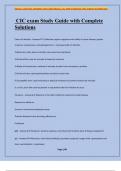EMILLECT 2024/2025 ACADEMIC YEAR ©2024 EMILLECT. ALL RIGHTS RESERVED. FIRST PUBLISH OCTOBER 2024.
CIC exam Study Guide with Complete
Solutions
Chain of Infection - Answer✔✔-1)Infectious agent= organism with ability to cause disease; greater
virulence, invasiveness, and pathogenicity => increased odds of infection
2) Reservoir: place where microbes can persist and reproduce
3) Portal of Exit: way for microbe to leave the reservoir
4) Mode of transmission: method of microbe transfer from one place to another
5) Portal of entry: opening that allows microbe to enter host
6) Susceptible host: Lacks immunity or physical resistance to prevent invasion by microbe
Is a circle; each link must be present in sequential order for infection to occur
Virulence - Answer✔✔-Measure of microbe's ability to invade and create disease
Depends on ability to:
Survive in environment between hosts
Transmit between hosts (moving; adherence)
Proliferate
IgM - Answer✔✔-Pentamer; primary response, short-lived (<6 months); best at fixing complement
IgG - Answer✔✔-Monomer; main blood antibody, secondary response; longer lived. opsonization and
toxin neutralization. 4 subclasses
Page 1/46
,EMILLECT 2024/2025 ACADEMIC YEAR ©2024 EMILLECT. ALL RIGHTS RESERVED. FIRST PUBLISH OCTOBER 2024.
Physical barriers - Answer✔✔-Skin; fever; secreted antimicrobials; innate immunity
Complement system - Answer✔✔-11=protein cascade; classically activate by ab:ag complexes; alternate
by pathogen surfaces
Skin defects; examples and associated pathogens - Answer✔✔-Wounds, burns, trauma, serious derm
problems, indwelling devices, injections. Skin flora- S. aureus, CNS, strep pyo, corynebacteria, malassezia
furfur
Mucous membrane barrier defects; examples and associated pathogens - Answer✔✔-chemo-induced
mucositosis, head/neck trauma, smoking, inhalational injury, antacids/PPIs. Resident flora- anaerobes,
aerobic GNR, candida, enteroccus, bovis
Body passage obstruction; examples and associated pathogens - Answer✔✔-Tumors, foreign bodies,
stones, cystic fibrosis. Resident flora overgrow or invade; site-specific.
Abnormal number or function of granulocytes - Answer✔✔-Leukemia, chemo, congenital disorders,
diabetes. If short term (< 2 wks) then aerobic GNR, Sa, CoNS. IF long term, add fungi (candida, t. glabrata,
aspergillus)
Abnormalities of cell-mediated immunity - Answer✔✔-BMT, HIV, steroids, malnutrition, 3rd tri
pregnancy. Bacteria: Intracellular pathogens (listeria, salmonella, mycobacteria, nocardia, legionella).
Fungi: candida, Cryptococcus, coccidioides, histoplasma. Virus: Herpes group
Also toxoplasma and strongyloides.
abnormalities of humoral immunity - Answer✔✔-BMT, HIV, some cancers, aging. Strep pneumo,
encapsulated H. flu, Neisseria meningitidis
Page 2/46
,EMILLECT 2024/2025 ACADEMIC YEAR ©2024 EMILLECT. ALL RIGHTS RESERVED. FIRST PUBLISH OCTOBER 2024.
Preventing infection for immunocompromised patients - Answer✔✔-Take thorough patient history.
Prepare before starting with all vaccines, procedures, line placement, screening. Support gastric acidity.
Prevent exposures with awesome hygiene, approp food and water precautions, visitor education, no
flowers or plants, and possible abx prophy (for infections that might reactivate or high-risk for
pneumocystis)
Mycoplasma spp. - Answer✔✔-No cell wall --> limited abx choices. Cause atypical pneumonia. Usually
diagnosed by serology
Chlamydiae - Answer✔✔-obligate intracellular parasites. Elementary body=infectious, reticulated=
intracellular. DFA or ELISA for detection of antigen is most common. Can also detect antibodies.
Rickettsiae - Answer✔✔-obligate intracellular parasites. arthropod vectors. Rarely culturing; detected by
serology using ELISA for antibodies.
Textbook viral replication cycle - Answer✔✔-1. Attachment 2. penetration/entry 3. replication 4.
maturation/assembly 5. release
Sensitivity - Answer✔✔-% of true + who test +; inherent to test
Specificity - Answer✔✔-% of true neg who test neg; inherent to test
PPV - Answer✔✔-Likelihood that a + test represents a true case (% T+/all+); depends on the test and on
prevalence of disease in population
NPV - Answer✔✔-Likelihood that a negative test result is a true non-case (%TN/allN); depends on test
and population prevalence
Page 3/46
, EMILLECT 2024/2025 ACADEMIC YEAR ©2024 EMILLECT. ALL RIGHTS RESERVED. FIRST PUBLISH OCTOBER 2024.
CSF analysis- bacterial mening - Answer✔✔-1000-5000 WBCs, mostly PMNs. Increased pressure.
Increased protein . Decreased glucose. Bacteria seen on smears.
CSF analysis- viral mening - Answer✔✔-Pressure, glucose normal. Lymphocytes seen, but few WBC in
general. Protein normal-elevated. Nothing on smears.
CSF analysis- fungus mening - Answer✔✔-Pressure variable. Glucose low, protein high. WBCs vary, but
lymphocytes predominate. India ink smear +.
CSF analysis- TB mening - Answer✔✔-Pressure variable. Glucose low to megalow. WBCs vary, mostly
lymphocytes. Protein elevated. AFB stain +
Cold Agglutinins test - Answer✔✔-Used to detect antibodies for Mycoplasma pneumoniae or
mononucleosis. Positive test is high titer, with resp Sx indicates M. pneumo infection, viral pneumo, or
primary atypical pneumo
CRP test - Answer✔✔-Serum sample looking for the CR protein; normal value is none or low CRP.
Indicates current acute inflammation
Liver Function Tests - Answer✔✔-chemistry assays on blood; looking for various things including
enzymes, bilirubin, ammonia, and albumin. Generally higher is worse. Helps detect liver problems,
differentiate among liver problems, measure liver damage, and follow response to Tx.
Arterial Blood Gas (ABG) - Answer✔✔-blood from artery, measures oxygen and CO2 tension, pH.
Assesses gas exchange, which is helpful in recognizing pneumonia
Sedimentation rate - Answer✔✔-Measures rate of RBCs sinking; faster indicates acute
infection/inflammation (among other things, is not very specific)
Page 4/46




